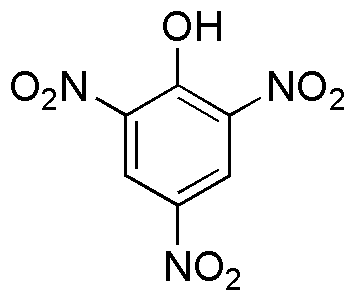Picric acid is widely utilized in research focused on:
- Explosives Manufacturing: Due to its high explosive properties, picric acid is used in the production of military and industrial explosives, offering a stable alternative to other compounds.
- Dyes and Pigments: It serves as a precursor in the synthesis of various dyes, particularly in the textile industry, providing vibrant colors and excellent fastness properties.
- Pharmaceutical Applications: In the medical field, picric acid is used in the formulation of antiseptics and as a reagent in the analysis of certain compounds, enhancing diagnostic capabilities.
- Research Reagent: It is commonly employed in laboratories for the detection of proteins and amino acids, facilitating biochemical research and analysis.
- Histology and Microscopy: Picric acid is utilized in tissue fixation and staining, improving the clarity and detail of microscopic samples, which is crucial for histopathological studies.
General Information
Properties
Safety and Regulations
Applications
Picric acid is widely utilized in research focused on:
- Explosives Manufacturing: Due to its high explosive properties, picric acid is used in the production of military and industrial explosives, offering a stable alternative to other compounds.
- Dyes and Pigments: It serves as a precursor in the synthesis of various dyes, particularly in the textile industry, providing vibrant colors and excellent fastness properties.
- Pharmaceutical Applications: In the medical field, picric acid is used in the formulation of antiseptics and as a reagent in the analysis of certain compounds, enhancing diagnostic capabilities.
- Research Reagent: It is commonly employed in laboratories for the detection of proteins and amino acids, facilitating biochemical research and analysis.
- Histology and Microscopy: Picric acid is utilized in tissue fixation and staining, improving the clarity and detail of microscopic samples, which is crucial for histopathological studies.
Documents
Safety Data Sheets (SDS)
The SDS provides comprehensive safety information on handling, storage, and disposal of the product.
Product Specification (PS)
The PS provides a comprehensive breakdown of the product’s properties, including chemical composition, physical state, purity, and storage requirements. It also details acceptable quality ranges and the product's intended applications.
Certificates of Analysis (COA)
Search for Certificates of Analysis (COA) by entering the products Lot Number. Lot and Batch Numbers can be found on a product’s label following the words ‘Lot’ or ‘Batch’.
*Catalog Number
*Lot Number
Certificates Of Origin (COO)
This COO confirms the country where the product was manufactured, and also details the materials and components used in it and whether it is derived from natural, synthetic, or other specific sources. This certificate may be required for customs, trade, and regulatory compliance.
*Catalog Number
*Lot Number
Safety Data Sheets (SDS)
The SDS provides comprehensive safety information on handling, storage, and disposal of the product.
DownloadProduct Specification (PS)
The PS provides a comprehensive breakdown of the product’s properties, including chemical composition, physical state, purity, and storage requirements. It also details acceptable quality ranges and the product's intended applications.
DownloadCertificates of Analysis (COA)
Search for Certificates of Analysis (COA) by entering the products Lot Number. Lot and Batch Numbers can be found on a product’s label following the words ‘Lot’ or ‘Batch’.
*Catalog Number
*Lot Number
Certificates Of Origin (COO)
This COO confirms the country where the product was manufactured, and also details the materials and components used in it and whether it is derived from natural, synthetic, or other specific sources. This certificate may be required for customs, trade, and regulatory compliance.


